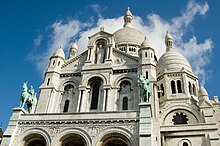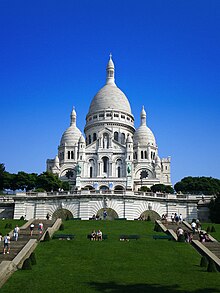![]() Publicado en France - Entretenimiento y Ocio - 20 May 2016 04:06 - 3
Publicado en France - Entretenimiento y Ocio - 20 May 2016 04:06 - 3

 For other Basilicas of the same name, see Basilica of the Sacred Heart (disambiguation).Basilica of the Sacred Heart of Jesus
For other Basilicas of the same name, see Basilica of the Sacred Heart (disambiguation).Basilica of the Sacred Heart of JesusBasilique du Sacré-Cœur (French)Basic informationLocationGeographic coordinatesAffiliationProvinceYear consecratedEcclesiastical or organizational statusWebsiteArchitectural descriptionArchitect(s)GroundbreakingCompletedSpecificationsLengthWidthHeight (max)MaterialsThe Basilica of the Sacred Heart of Paris, commonly known as Sacré-Cœur Basilica and often simply Sacré-Cœur (French: Basilique du Sacré-Cœur, pronounced ), is a Roman Catholic church and minor basilica, dedicated to the Sacred Heart of Jesus, in Paris, France. A lar landmark, the basilica is located at the summit of the butte Montmartre, the highest point in the city. Sacré-Cœur is a double monument,
political and cultural, both a national penance for the defeat of France
in the 1871 Franco-Prussian War and the socialist Paris Commune of 1871 crowning its most rebellious neighborhood, and an embodiment of conservative moral order, publicly dedicated to the Sacred Heart of Jesus, which was an increasingly lar vision of a loving and sympathetic Christ.The Sacré-Cœur Basilica was designed by Paul Abadie. Construction began in 1875 and was finished in 1914. It was consecrated after the end of World War I in 1919.
In response to requests from French bishops, Pope Pius IX promulgated the feast of the Sacred Heart in 1856. The basilica itself was consecrated on 16 October 1919.Since 1885 (before construction had been completed), the Blessed Sacrament (a consecrated host which, according to Church teaching, has become by the consecration of the priest Christ's Body and Blood during M) has been continually on display in a monstrance above the high altar. Perpetual adoration of the Blessed Sacrament has continued uninterrupted in the Basilica
since 1885. Because of this, tourists and others are asked to dress
appropriately when visiting the basilica and to observe silence as much
as possible, so as not to disturb persons who have come from around the
world to pray in this place of pilgrimage.
The Basilica is accessible by bus. Buses 30, 31, 80, and 85 can be taken to the bottom of the hill of the Basilica. Line 12 of the metro
can be taken to Jules Joffrin station and visitors can then change to the Montmartrobus and disembark at Place du Tertre. Line 2 or 12 of the metro can be taken to Pigalle station where visitors can change to the Montmartrobus and disembark at Norvins, or to Anvers station which gives easy access to the steps or the funicular car that lead directly to the Basilica.Sacré-Cœur is open from 06:00 to 22:30 every day. The dome is
accessible from 09:00 to 19:00 in the summer and 18:00 in the winter.
Endosar





